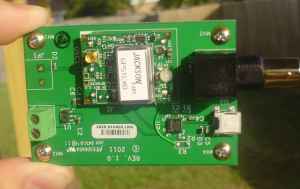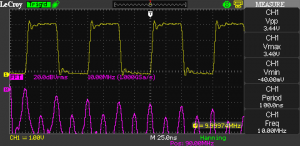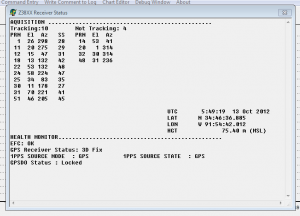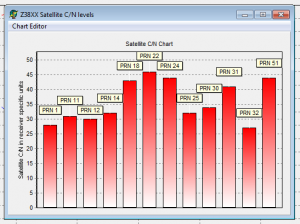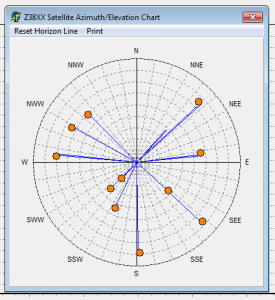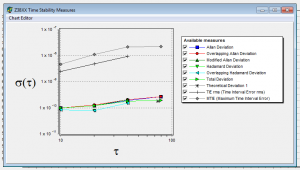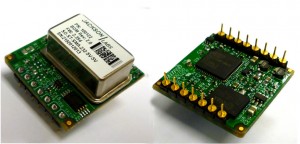The GPS-disciplined Oscillator (GPSDO) reviewed in this article is a state-of-the-art eval board from Jackson labs equipped with a high-performance GPS receiver, a 32-bit MCU, a TCXO and the necessary circuitry / software to make a GPSDO. The GPS receiver can track up to 50 satellites at the same time even with received signal strength down to -160 dBm. The manufacturer certifies its product with an accuracy of typically better than 2 ppb when locked to GPS.
The evaluation board comes with a GPS antenna, a CD with software and a USB cable. After connecting the board to a PC for the first time, it identifies itself as a USB serial port. Thanks to the industry standard FT232, no external drivers will need to be installed on most Windows / Unix systems.
A mini USB connector, a BNC connector for the 10 MHz reference output, a screw terminal for an external 5 V power supply, and a small rf connector for the antenna – that’s all the peripherals the board needs.
The board has a dual LED (red / green) for status indication. The red LED is the 1 Pulse Per Second PPS signal. Although the definition of ‘pulse’ is really stretched here as the signal seems to have a duty cycle of 50 %, it doesn’t affect the functionality. The 1 PPS signal is also available on the DCD pin of the USB serial port.
The green LED is the lock indication. The LED will light up when the oscillator has been locked to the GPS reference.
Upon connection to a power source, both colors of the dual LED will light up for a few seconds and go dark again. If the satellite receiver is happy with the received GPS signals, the red 1 PPS LED will start blinking with a frequency of 0.5 Hz. The transition (on <-> off) marks the 1 PPS pulse.
Once the oscillator is locked to the GPS reference, the green LED will start lighting constantly. Jackson Labs mentions a time frame of up to 1 hour in the datasheet. At no point has my module even remotely taken that long. The maximum time frame I observed was about 15 minutes (outside, windy conditions). The LED may go off occasionally if the ambient temperature changes.
The software that comes with the board is fairly neat to read and write all kinds of parameters to and from the board. Different windows can be activated and viewed at the user’s discretion.
The displayed data isn’t limited to the GPSDO function at all. For instance, detailed data about the received satellites can be displayed.
The menus and windows of the software are self-explanatory and easy to operate.
The most interesting window to me was the “time stability measures” window. I placed the evaluation board outside on a moderately windy day. I also made sure the sun exposure would change by occasionally shadowing the sunlight. Take a look at the following picture to see what small impact this actually had on the stability:
All in all, the board is extremely easy to be used in own software developments. Jackson Labs chose the Standard Commands for Programmable Instruments (SCPI), an IEEE-488 extension, instead of implementing an own proprietary protocol. This makes the development of own software products so much easier.
As mentioned beforehand, the 1 PPS signal is also available on the DCD pin of the USB serial port. This feature can be used for Network Time Protocol (NTP) purposes. The free Linux based software daemon GPSD [1] is fully compatible with this board and turns every Linux / FreeBSD computer into a precise network time reference.
The 1 PPS pulse is also available with LVCMOS-level from the unpopulated pads of R3. 200 ms high and 800 ms low is the exact timing of the signal. The rising edge is aligned to the UTC second.
The board can be set to output NMEA sentences. GPRMC and GPGGA sentences can be retrieved through the USB serial port. The user’s manual explains exactly how to set the board into NMEA mode. See Section 4.3.4 for details [2].
The whole evaluation board fits perfectly into a Hammond case #1455C801BK, which is available from most major distributors. I highly recommend to use a casing as it will stabilize the influence of wind and other slight changes in ambient temperature drastically.
Jackson Labs kindly supplied long-term phase noise and Allan deviation measurement for the Eval board in the aforementioned Hammond case.
The eval board is available for $300 directly from Jackson Labs [3]. For a brand new GPSDO with the aforementioned specs, this is an excellent price.
Jackson Lab offers an extremely small (0.97″ x 0.97″), low-power (0.5 W) GPSDO module called ‘LC_XO’ [4]. The LC_XO is available as TCXO or more stable OCXO version. It is electrically identical to the module populated on the eval board. The module can be soldered onto a PCB or be mounted using standard 100 mil headers.
Please note that the module itself provides TTL level RS232 signals. For USB-interfacing a standard off-the-shelf USB / Serial converter (e.g. FT232RL) will be needed. And even though the LC_XO module is designed for industry standard 3.3 V, the module does supply 5 V on an extra pin for external circuitry. For pricing and lead times please contact Jackson Labs directly [3].
Links and Sources:
[1] GPSD, GPS Service Daemon: http://catb.org/gpsd/
[2] User Manual, Jackson Labs: http://www.jackson-labs.com
[3] Contact us, Jackson Labs: http://www.jackson-labs.com
[4] LC_XO product page, Jackson Labs: http://www.jackson-labs.com/
Westerhold, S. (2012), "Review: Jackson Labs GPSTCXO Eval Board". Baltic Lab High Frequency Projects Blog. ISSN (Online): 2751-8140., https://baltic-lab.com/2012/10/review-jackson-labs-gpstcxo-eval-board/, (accessed: January 2, 2026).
- Conducted Emissions on the Bench: Implementing the CISPR 25 Voltage Method - December 15, 2025
- WebP-Images without Plugin - January 14, 2025
- Firewall Rules with (dynamic) DNS Hostname - January 14, 2025
